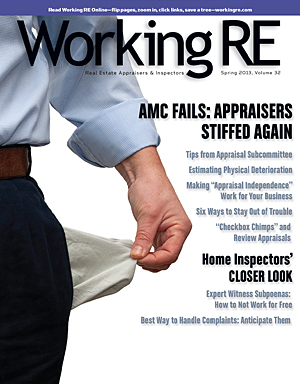
|
Published by OREP, E&O Insurance Experts | May 2013 |

Click to Read Current Issue |
|
If you've built
it, will they come? Certainly likability will help you win over some hearts,
but just being the nice guy won't get you to the closing table. You
eventually need to get down to business.
The Relationship Business - Part 2
By Melissa Dittmann Tracey
Step 2: Maintenance Mode
You’ve made the introduction and extended the handshake. Now, how do you
keep this budding relationship growing?
Tip:
Start off with a blitz.
Get in touch with a prospect eight times within eight weeks following an
introduction. The “8×8” program is what Donna Boylan, productivity coach at
Keller Williams Consultants Realty in Dublin, Ohio, teaches agents for
keeping in touch. The program centers on the idea that people need to be
exposed to something eight times before they remember it—and that “it”
includes you. The forms of contact will differ (for instance, phone, e-mail,
postcards, and so on) and should be tailored to that person (such as
potential first-time home buyer or seller), Boylan says. The content could
include anything from a “thinking of you” card to mortgage information to a
market comparison of the person’s neighborhood.
Tip:
Get attention with the occasional less-than-serious missive.
Need to add pizzazz to a blog post, e-mail, or other communications? Have
some fun: Hallmark offers up a
list of nontraditional “holidays” to celebrate.
For example, in honor of “National Dress Up Your Pet Day” on Jan. 14, you
could promote a contest on your social networks for best-dressed pooch.
Invite your prospects over for a sweet get-together on Feb. 7 to celebrate
“National Chocolate Fondue Day.” On Feb. 25, swap the best chili recipes on
“National Chili Day.” Or just send a thoughtful card in honor of Feb. 7,
“Send a Card to a Friend Day.” Silly occasions offer a vehicle for making a
fun and memorable connection. A Keller Center study, “What Do Consumers
Expect From Agents?” supports the effectiveness of humor in business; a real
estate agent with a good sense of humor is more likely to have a positive
reputation as someone customers want to work with, according to the 2008
report.
Be sure to balance the entertaining with the useful. You’ll find a vast
array of valuable content on buying, selling, and maintaining and improving
your house at HouseLogic.com’s REALTOR® Content Resource. The handouts are
free of charge for NAR members and customizable. Prospects will love your
tips on buying, selling, energy efficiency, money-saving remodeling ideas,
and more.
(story continues below)
(story continues)
Tip:
The thought really does count.
Handwritten notes are a great way to acknowledge birthdays, graduations,
wedding anniversaries, a new baby, and even a pet’s birthday. But sometimes
you may want to offer something extra.
Carlyn Parker, a sales associate with Real Living CO Properties in Denver, tailors her approach to the client. For example, for a relocating family on a house-hunting trip over Easter weekend eight years ago, Parker made up Easter baskets for the small children, who were 2 and 4 at the time. Now she pays a yearly visit to the family with Easter baskets in hand. The visits help keep the relationship alive and have led to three real estate transactions so far. For other families, she’ll try other things, such as “wine of the month” club.
Dolores Mauriello, ABR, a broker with Century 21 Gemini LLC Realty in Wayne, N.J., offers a Lowe’s 10 percent off coupon to those she meets at open houses. All they have to do is provide their e-mail address so she can follow up. She uses the Lowe’s REALTOR Benefits® Program, a free service available to REALTORS®, to send a customized, real estate newsletter, along with the coupon.
Tip:
Find reasons to get face-to-face.
Avoid becoming just a name on someone’s social network or a spam in an
e-mail in-box. Put in some face time with your prospects. Some real estate
professionals do this by holding an office open house, a special dinner, or
a fund-raiser for a local charity. Sheri Bailey, a practitioner with Keller
Williams Boerne in Boerne, Texas, invites prospective female buyers to lunch
every month or so. “Especially if they are new to the area, my clients love
to try out a local restaurant while we catch up on the latest happenings in
their lives,” Bailey says. “For the price of a sandwich or salad, I can stay
in touch.” Even if there’s no explicit conversation about real estate, she
says the meetings are valuable to strengthen those relationships. Remember,
though, in order to count such a lunch as a business expense for federal tax
purposes, the main purpose of the lunch must be business; you must discuss
business before, during, or after the meal; and you must have a reasonable
expectation of generating income or some other business benefit.
Step 3: Getting Down to Business
If you’ve built it, will they come? Certainly likability will help you win
over some hearts, but just being the nice guy won’t get you to the closing
table. You eventually need to get down to business.
Tip:
Don’t be afraid to have a point of view.
Blocker’s research, which tested various approaches in real estate for
turning leads into clients, shows agents are most effective when they not
only adapt to their client’s style but also look for ways to make clear,
explicit suggestions that advise a specific course of action. “The agent who
offers expertise instead of ‘here’s a stack of things to look through’ tends
to have a higher success rate,” Blocker says.
For example, say you’re working with Judy, a buyer who is stressed out about not living close enough to her job. Weave those concerns into your discussions with Judy. If a house she’s considering is closer to work and has a great space for her to work from home, talk about how those factors might reduce her stress. “Help prospects see themselves in that home and neighborhood,” Blocker says. “Speak their language and pull at their heart strings.”
Tip:
Watch for turnoffs.
Housing data, sales scripts, and incentives can all be useful tools to a
point. But relying on them too much can actually backfire, according to
Blocker’s research. “There’s a tremendous amount of housing data available,”
Blocker says. “Too much information can sometimes cause people to ‘check
out’ ” or feel overwhelmed, particularly if the information is presented
with no explanations or recommendations. If you offer a packet of
information and they actively consult it, they may want more. If they shove
it into their bag and never refer to it again, they may not be
information-oriented.
Buttering people up with incentives—like an offer to discount your
commission—may not be effective either, the study found. “Basically, you’re
trying to appeal to the client’s wallet, and that can be a turnoff,” Blocker
says. “They don’t want to feel pressured to make a decision.”
And while sales scripts can be a useful guide to navigate various client
situations, they can potentially undermine those interactions. Relationships
are complex. People have unique personalities, life histories, and goals
that don’t fit into one boilerplate script. So be flexible enough to go off
script and tailor your presentation to individual clients, Blocker says.
Tip:
Inspire gratitude.
A considerate gesture can go a long way—and it doesn’t have to cost money.
Recommend a great contractor or painter who will offer a good price; take
the time to ask how someone’s doing after a surgery or family death; or
refer their teenage child for a job. Gratitude is a powerful emotion that
makes others want to reciprocate.
“After receiving a benefit, people feel a deep-rooted psychological pressure
to reciprocate,” according to a 2009 Keller Center study on gratitude by
Robert W. Palmatier. On the other hand, the study says, “the failure to
repay obligations can lead to guilt.” As the saying goes, “You scratch my
back; I’ll scratch yours.”
To feel gratitude, others need to feel that your
actions and concern for their well-being are sincere and not selfish or
commission-motivated. So, by all means, seek opportunities to reach out. But
do it simply for the wonderful bond you’ll create.
*Reprinted from the January/February 2013 issue of REALTOR Magazine
by permission of the NATIONAL ASSOCIATION OF REALTORS. Copyright 2013. All
rights reserved.
ATTENTION: You are receiving WRE Online News because you opted in at WorkingRE.com or purchased E&O insurance from OREP. WRE Online News Edition provides news-oriented content twice a month. The content for WRE Special Offer Editions is provided by paid sponsors. If you no longer wish to receive these emails from Working RE, please use the link found at the bottom of this newsletter to be removed from our mailing list.



